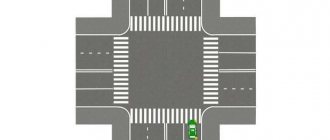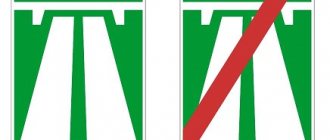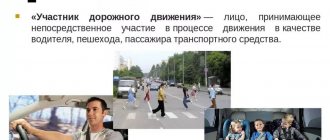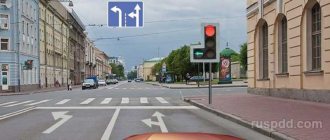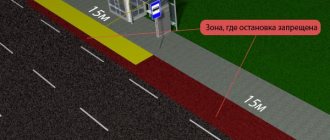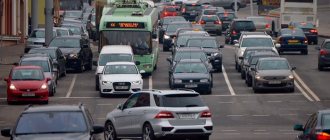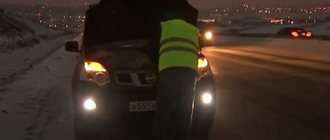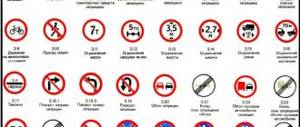These signs warn you that you are approaching:
| 1. | Towards a railway crossing without a barrier. |
| 2. | Towards a railway crossing with a barrier. |
| 3. | To the place of work on the road. |
The main sign “Railway crossing with barrier” outside populated areas is installed at a distance of 150 to 300 m before the crossing, in addition, the same sign is installed again at a distance of at least 50 m before the crossing.
“Approaching railroad crossing” signs provide additional warning that you are approaching a railroad crossing. They are used only outside populated areas.
Signs
A railway crossing sign is installed near such a crossing, and the icon indicates the designation of its type.
There are several options:
- there may be a single track in front;
- multi-track road.
If the tracks are single-track, this means that only one train can move on such rails, which goes in one direction. Such a road carries no less danger. When the train has passed, you can continue moving after you hear the permission signal.
A crossing road sign may indicate that there is a multi-track road ahead. This implies that composition can be expected from either side. The sign will warn of approaching trains. If the train has passed, but the prohibitory signal is still on, you should not move. Perhaps the train is moving from a different direction.
It should also be noted that a crossing sign is installed 200 meters or less before the crossing if we are not talking about a populated area. You need to pay attention to how many stripes are shown on the sign. Often such images are found in the coloring books of a child whose parents teach him safety from childhood.
When three stripes are drawn, this indicates that there are about 150 meters left to the tracks. Accordingly, 100 meters - two lanes and 50 - one. In photographs and in real life, the sign will look like a rectangular background with a red oblique line. Install it on the right side of the road.
For his safety, the driver must take into account the established rules at each interval of the roadway. According to GOST, it is stipulated that signs are also installed indicating that it is forbidden to move without stopping. This suggests that the driver must take the following action: stop the vehicle and make sure there are no trains.
When a train moves along the rails, you need to give way to it. In villages and other areas, most often, the stop does not last more than two minutes. This is due to the fact that during such a period of time the driver can fully assess the current situation and understand whether it is worth driving or not.
Can you outrun a tractor?
| 1. | No. |
| 2. | Yes. |
| 3. | Yes, if overtaking is completed 100 m before the crossing. |
Overtaking is prohibited at railway crossings and closer than 100 m in front of them. Since the railway crossing is located outside the populated area, the signs “Railway crossing without a barrier” and “Approaching a railway crossing” are installed at a distance of 150-300 m before the crossing. Therefore, you can start overtaking the tractor in this situation if the overtaking is completed 100 m before the crossing.
Highlights
Railroad crossings must be equipped with special technical devices that notify drivers of the approaching train and block their path.
Photo: road signs indicating approaching a railway crossing
Crossings can be regulated, and as a result, equipped with traffic lights, barriers and sound sirens, or unregulated, which means the driver needs to independently monitor the presence of a train.
By the way, the latter are preserved only in places with very low traffic intensity outside the city, while in populated areas and on busy arteries there are only equipped zones.
Traffic at crossings is controlled both directly by traffic police inspectors, who also carry out explanatory work, and by automatic cameras, which are installed at some crossings, and increasingly, drivers who violate traffic rules receive fines recorded precisely in automatic mode.
Thus, if a driver violates the rules and drives through a prohibiting signal, or when the barrier is lowered, he will face a penalty or a ban on driving vehicles.
Basic Concepts
To understand what rules apply in terms of using railway crossings, you should familiarize yourself with the basic concepts in force in the field, which will allow you to understand how railway crossings work, what is prohibited to do on them, and also how to properly cross the crossing.
| Term | Meaning |
| Railway crossing | A specially equipped and equipped area that serves for the safe crossing of rails, does not allow a train to collide with a car, and also notifies drivers in advance of the need to stop and let the train pass. |
| Traffic light | Signaling equipment that tells drivers to stop, allows them to move, and warns them when signals change. In most cases, it is on the basis of traffic lights that traffic at intersections is regulated |
| Barrier | A special traffic limiter in the form of a barrier that does not allow cars to pass and forces them to stop exactly at the distance from the rails that can be considered safe |
| Anti-ramming device | A special technical device that extends out of the ground and prevents vehicles from passing, acting as a barrier. Most often, such mechanisms are automatic and will not work if a car is standing on them, so their activation is absolutely safe for transport |
What does the traffic regulations say?
The traffic rules say that, first of all, the driver must comply with the requirements of the signs and markings that are on the road section, and also not violate the prohibitions that are indicated by the alarm or by the responsible person, for example, a traffic controller.
In addition, the Traffic Rules absolutely prohibit overtaking in a zone 100 meters from the crossing, and cars should only move in one row, unless markings allow otherwise, or a special road sign indicating the number of lanes is installed.
These signs warn you:
| 1. | About approaching a railway crossing with three tracks. |
| 2. | About the presence of a railway crossing without a barrier in 150-300 m. |
| 3. | About the presence of a railway crossing in 50-100 m. |
In front of you is a sign for a railway crossing without a barrier. The sign “Approaching a railway crossing” with three stripes installed underneath is only an additional warning about approaching the crossing. Outside populated areas, this combination of signs is installed at a distance of 150 to 300 m before the crossing.
What signs are installed immediately before a railway crossing?
| 1. | Only A. |
| 2. | Only B. |
| 3. | Only in. |
| 4. | A and B. |
Answer
| Sign B “Multi-track railway” is installed closest to the railway crossing. It is placed in front of railway crossings without a barrier on the same support as traffic lights, and in their absence, at a distance of at least 20 m from the nearest rail. |
| Signs A “Railway crossing with a barrier” and “Approaching a railway crossing” are installed only on roads outside populated areas at a distance of at least 50 m from the dangerous area. |
| Signs B “Railway crossing without a barrier” and “Approaching a railway crossing”, respectively, 150-300 m before it. |
The correct answer is Only B.
Topic 15. Traffic across railway tracks
A railway crossing is an extremely dangerous section of the road. This is where the most serious accidents occur, because a loaded train traveling at a speed of 80 km/h has a stopping distance of about a kilometer! He physically cannot stop instantly.
Therefore, they try to properly equip and mark railway crossings. These include traffic lights, barriers, and often a crossing guard. And recently, automatic barriers have begun to be installed more and more often.
You can only cross railroad tracks at railroad crossings.
Even if the crossing is open, you need to make sure there is no approaching train
. Indeed, in the event of an obstacle on the tracks, the driver must move to the second section of the locomotive (in order to survive), and not brake, as you would like.
Below we will look at cases when driving to a railway crossing is strictly prohibited.
.
The most obvious reasons not to throw yourself in front of a train are a closed (or beginning to close) barrier, prohibiting the traffic light signal or the crossing duty officer.
. Even if they contradict each other, it is better to stop.
Let's say the barrier is closing. And the traffic light continues to light with a permissive signal (maybe some relay is “stuck”...). It doesn't matter! The main thing is that a prohibiting signal appeared in the form of a barrier. This means that traffic through the crossing is prohibited.
Or vice versa: a prohibitory traffic light came on - there are two of them. For some drivers, one plus sound is not enough, indicating that a train is approaching. And the barrier is still open at this moment - perhaps the fuse of the engine has burned out or the wire has rusted... Anything can happen in Russia. But despite this, the ban is already in effect. You are not allowed to travel!
For some drivers, one plus sound is not enough, indicating that a train is approaching. And the barrier is still open at this moment - perhaps the fuse of the engine has burned out or the wire has rusted... Anything can happen in Russia. But despite this, the ban is already in effect. You are not allowed to travel!
If the crossing guard in an orange vest waves a red lantern (at night) or a flag (during the day) or blocks traffic with his chest (and arms spread to the sides), stop. These are also prohibition signals.
If there is a traffic jam behind the crossing
, you should not drive onto the tracks.
A traffic jam can force the driver to stop right at the crossing. The vehicles driving behind will “back up” him, and he will simply find himself a victim of the train, a hostage of the situation. The car in the photo on the left, which entered the railway track at a prohibited moment, was “dragged” by the train along the rails for several tens of meters.
It is also necessary to stop before crossing if a train appears within sight.
. No comments here.
It is not allowed to pass oncoming cars in front of the crossing.
.
Crossings are usually quite narrow. And the driver, who has driven onto the wrong half of the road, blocks the oncoming traffic, which threatens an accident at the crossing.
And the next traffic rule probably only exists in our country.
You cannot open the barrier without permission
. It was not put there by you 
tractors or construction vehicles are not allowed to cross the crossing.
.
And slow-moving vehicles moving less than 8 km/h
are better off not traveling on the tracks without permission from the railway supervisor.
When driving through a crossing is prohibited, the driver must stop at a stop line, sign or traffic light. And if there are none, no closer than 10 meters to the nearest rail.
If there is a barrier at the crossing, then do not stand closer than 5 meters, and if there is none, stand no closer than 10 meters from the nearest rail.
In the event of a forced stop at a crossing, the driver must first get rid of passengers.
Only after this the driver is obliged to take one hundred grams of courage to clear the crossing.
You should not try to “reanimate” the engine in a car with passengers. Especially seeing the train approaching. Let at least someone be safe.
What can you do if the engine stalls?
at the worst possible moment?
Let the engine not start. But if you have a manual transmission, you can engage first gear, fire the starter, and the car will start moving. Of course, you won’t be able to go home 100 kilometers (or even 10) like that - just burn out the starter. However, moving the car 10-15 meters in a critical situation is quite possible. Free up your move and, perhaps, save your life and not only that.
If you cannot move the vehicle, you must warn the driver of the approaching train.
To do this, the driver must send the disembarked passengers in both directions along the railway tracks for 1000 meters. If there is only one passenger, then in the direction of worse visibility of the railway track. They should try to stop the train by waving their arms in a circle, preferably with a brightly colored rag in their palms. At night, it should be replaced by a torch or flashlight (at worst, a flashlight on a mobile phone).
During this time, the driver should remain in the vehicle to sound the general alarm signal of one long and three short beeps. And when a train appears, run towards it, giving stop signals.
We hope nothing like this ever happens to you. But now you at least know what to do in case of an emergency
Which driver violated the parking rules?
| 1. | Both did not violate. |
| 2. | Both violated. |
| 3. | Only the driver of car B. |
| 4. | Only the driver of car A. |
Both drivers violated the Rules, since parking is prohibited within 50 m on either side of railway crossings.
Is such a maneuver allowed?
| 1. | No. |
| 2. | Yes, if there are no oncoming vehicles. |
| 3. | Yes, if the distance between the barrier and a stopped truck is 6 m. |
The driver of the truck stopped in accordance with the requirements of the Rules - no closer than 5 meters from the barrier, and passing vehicles standing in front of the crossing into oncoming traffic is prohibited.
